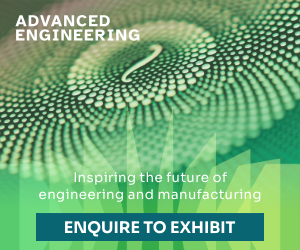An automated drilling solution comprising a FANUC cobot is using pre-qualified tools and process parameters to speed up aircraft production in response to booming order books and a record backlog within aerospace manufacturing. The ADUbot has been developed in conjunction with aerospace automation specialist Electroimpact and Luebbering, leading manufacturer of high precision fastening and drilling tools and technology. By automating the traditionally manual task of drilling thousands of holes in airframes – and using tools that have already been qualified– the ADUbot will assist aircraft manufacturers to rapidly achieve high levels of drilling autonomy, freeing up human employees to take on more value-added tasks.
Coping with record demand
“The record number of orders for aircraft over the next decade means that manufacturers and suppliers, across the whole supply chain, are having to streamline operations and cut cycle times while, at the same time, maintain the highest standards of quality and safety,” says Oliver Selby, Head of Sales at FANUC UK.
In a bid to help aircraft manufacturers increase production rates without impacting on quality, the FANUC/Electroimpact/Lueberring partnership identified drilling as a key application that would benefit from being automated.
“Traditionally, operators rely on a standard aerospace hand tool that uses a concentric collet locking interface to metallic drill templates or drill jigs that are attached to the wing. These drill tens of thousands of holes in aircraft every day – yet they are all operated by hand,” explains Robert Brownbill, Senior Mechanical Engineer for Deeside-based Electroimpact. “The operator must locate the end of the drill unit into the drill jig, then activate the locking collet to begin the process, drilling an incredibly high-tolerance hole into the structure. The collet is then unlocked, and the operator moves to the next hole.”
Accurate, fast and safe
By contrast, the ADUbot developed by FANUC, Electroimpact and Luebbering, sees a FANUC CRX-25iA cobot take over the manual aspects of this drilling process. As a collaborative robot, it is designed to operate safely with human personnel in close proximity. It can be quickly programmed for the task at hand and equally quickly be reprogrammed for the next job. It is mobile and can be moved easily from one location to another, making it especially suited for aircraft assembly operations.
Accuracy is also crucial – each hole has to be drilled to a very tight tolerance in terms of location and dimensions. “The use of FANUC’s Force Control routines allows us to utilise the existing manual drill jigs to locate ADUbot into the drill jig, and then we can command the ADU to drill the hole,” says Robert. “The ADUbot still requires some manual support in fixing the drill jig to the structure. However, once that’s done, ADUbot can be wheeled into place, the jig resync targets scanned, and the system left alone to complete the drilling processes. The major benefit to this process is that one operator can now operate many ADUbots, making it much more efficient.”

The ADUbot automates the traditionally manual task of drilling thousands of holes in airframes and assists aircraft manufacturers to rapidly achieve high levels of drilling autonomy, freeing up human employees to take on more value-added tasks.
Overcoming validation hurdles
A particular challenge for any new process within the aerospace industry is that it often requires qualification before it can be used on a flying aircraft. The validation process can be lengthy, which can discourage the adoption of even the most innovative new ideas and processes. Return on investment (ROI) usually has to be high to overcome this hurdle. FANUC, Electroimpact and Luebbering have turned that situation on its head by offering a solution that can be deployed immediately, with low capital investment.
“The beauty of the ADUbot is that it uses tools that have already been validated,” says Oliver Selby. “As end-users won’t have to go through the validation process, we can save them months in getting up to speed on automation. It’s a very cost effective solution with a fast ROI.”
The simple path to success
Drilling may appear to be a straightforward process to automate, and in many ways, it is. However, achieving the precision required for aerospace tolerances presents significant challenges. The simplicity of using a pre-qualified tool makes this the perfect application for automation. “When companies begin their automation journey, they often start with the more difficult-to-operate tasks,” states Robert. “But the more complex something is to operate manually, generally, the more expensive and more complicated it is to automate. The ADUbot is deliberately aimed at a task that is repetitive, routine and ultimately, easier and cheaper to automate. It’s the perfect entry-level system for companies that may be at the start of their automation journey, as well as those that are more familiar with robotics.”
Plugging the labour gap
Skills and staff shortages are squarely in the partners’ sights, too. “One of the biggest challenges we have heard from our customers is that they’re struggling to recruit the skilled workforce they need to increase their capacity. It’s therefore essential that manufacturers make the best possible use of their existing operators,” continues Robert. “Automating the ‘simpler’ jobs, such as drilling, frees up that skilled labour pool to carry out more complex tasks.”
This view is echoed by FANUC’s Oliver Selby: “The projected growth in the aerospace industry, with nearly 200 new aircraft to be delivered every month for the next 10 years, means that manufacturers across the supply chain have to work to shorten cycle times in every aspect of production. At the same time, the industry is facing skills shortages and a very tight supply of new recruits. The solution is automation – to get more robots carrying out more tasks, faster and reliably, helping human personnel to be more productive and focused where their skills and experience are most effective.”
Long-term collaboration
As a company that works with the world’s leading aircraft manufacturers in the USA, Europe and elsewhere, Electroimpact has enjoyed a long-running partnership with FANUC. The majority of its large-scale, complex and custom multi-axis machines are FANUC CNC controlled.
“We are delighted to announce the launch of this new solution, the latest fruits of FANUC’s long relationship with Electroimpact and Luebbering,” says Oliver. “The ADUbot will help suppliers and OEMs to cut cycle times and boost productivity, with a very low investment and rapid ROI. This is another step along the road to meeting rapidly rising demands for new aircraft in the global market.”







Leave a Reply